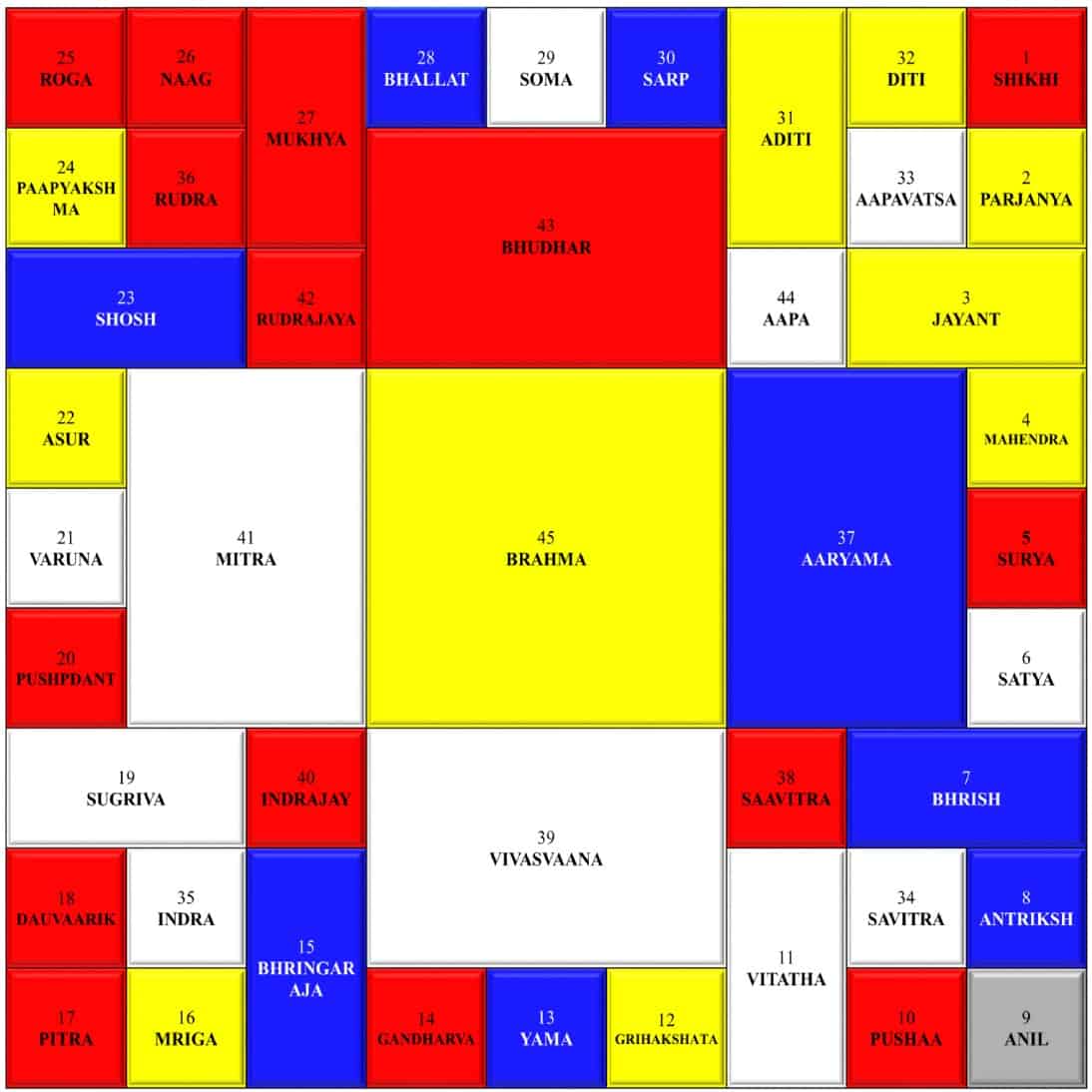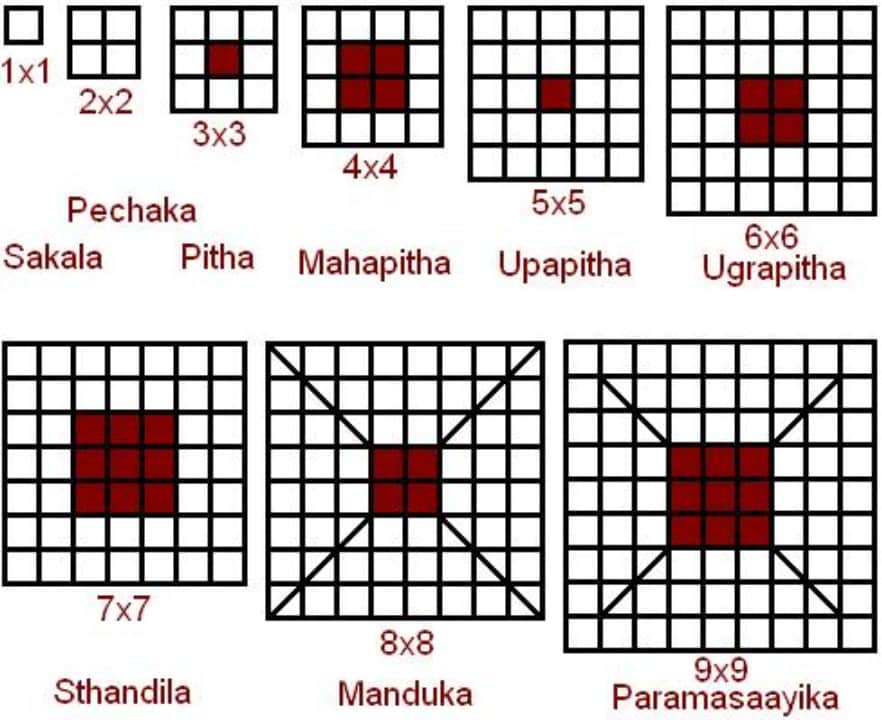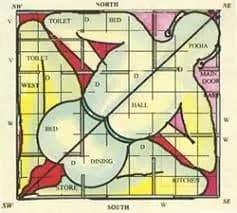Understanding the Vastu Purusha Mandala
In Hindu Mythology, a fierce conflict unfolded between the Devtas (Gods) and the Asuras (Demons). Lord Shiva ardently supported the Devtas. Amidst the battle against the demon Andhakasur, droplets of sweat trickled from Shiva’s forehead upon the earth. From these sweat droplets emerged a colossal being, recognized as Vastu Purusha. Asserting himself as the offspring of Lord Shiva, the colossal giant sought permission from Lord Shiva to consume ‘Triloka’ due to his insatiable hunger. As the giant commenced devouring Trilok, anxiety gripped the gods, prompting them to seek refuge in Brahma to avert a calamity.
To safeguard Triloka, Lord Brahma, with the assistance of the Ashta Dikapalakas (guardians of the eight cardinal directions), instructed other Devtas and Asuras to immobilize the giant on the earth. The directive was to position his head in the northeast and his feet in the southwest. In this arrangement, Brahma assumed the central position within Vastu Purusha, and the remaining 44 deities (representing 45 energy fields encompassing various facets of life) occupied distinct parts of his immense form. Brahma then bestowed blessings upon Vastu Purusha, decreeing that any structure constructed on earth would serve as his sustenance if not propitiated during construction. Thus, a belief emerged that performing this ritual when erecting a structure on an empty plot would invoke the blessings of the Devtas, while neglecting the ritual might incur the wrath of the Asuras, inviting hardship into one’s life.
Here are the key components of the Vastu Purusha Mandala:
- Symbolic Representation: The Vastu Purusha Mandala is a symbolic representation of the cosmic being or energy associated with a specific plot of land or a building. It is depicted as a square diagram divided into smaller squares, each representing a specific direction or sector.
- Orientation: In the Vastu Purusha Mandala, the cosmic being is imagined lying on the ground, with its head pointing towards the northeast and its feet towards the southwest. This orientation is significant, and the different directions are associated with specific energies and deities.
- Grid Structure:The Mandala is divided into smaller squares or “padas,” with each pada assigned to a specific deity, element, or force of nature. The central square is often considered the most sacred, representing the core or heart of the Vastu Purusha.
- Directional Associations: Each direction in the Mandala is associated with a particular deity or energy.

The diagram is segmented into 81 parts or squares called padas, constituting a 9×9 grid. Within this layout, Lord Brahma is positioned in the central pada referred to as Brahmasthaan, and the remaining 44 deities are placed in their designated locations. Out of the total deities, 32 gods are depicted in the outer enclosures, while 13 deities reside in the inner enclosures. These deities govern various aspects of life based on their inherent qualities. The foundational principle in any Vastu planning and design transcends the Vastu Purusha Mandala. Each room in a space must be planned in accordance with the characteristics of the 45 deities positioned on the Vastu Purusha Mandala. The Vastu Purusha Mandala includes two popular grids: the Manduka/Chandita Mandala with an 8×8 grid and the Paramasaayika Mandala with a 9×9 configuration, showcasing 64 and 81 squares called padas, respectively. Among Vastu practitioners, these two grids, especially the Paramasaayika Mandala, is commonly utilized for designing residences and palaces, while the Manduka Mandala finds application in the design of temples.
Manasara discusses 32 types of Mandalas, each designed for specific applications, including residential buildings, palaces, auditoriums, temples, and more. The following is a list of these diverse Mandalas along with their respective names for different sites:
- Sakala Mandala (1 square) corresponds to Eka-pada (single site)
- Pechaka Mandala (4 squares) corresponds to Dwi-pada (two division site)
- Pita Mandala (9 squares) corresponds to Tri-pada (three division site)
- MahaPita Mandala (16 squares) corresponds to Chatush-pada (four division site)
- UpaPita Mandala (25 squares) corresponds to Pancha-pada (five division site)
- UgraPita Mandala (36 squares) corresponds to Shashtha-pada (six division site)
- Sthandila Mandala (49 squares) corresponds to Sapta-pada (seven division site)
- Manduka/Chandita Mandala (64 square) corresponds to Ashta-pada (eight division site)
- Paramasaayika Mandala (81 squares) corresponds to Nava-pada (nine division site)
- Asana Mandala (100 squares) corresponds to Dasa-pada (ten division site)
- Sthaniya Mandala
- Desya Mandala
- Ubhaya-Chandita Mandala
- Bhadra Mandala
- Mahasana Mandala
- Padma-Garbha Mandala
- Tri-yuta Mandala
- Karnashtaka Mandala
- Ganita Mandala
- Surya-visalaka Mandala
- Susamhita Mandala
- Supratikanta Mandala
- Visalaka Mandala
- Vipra-garbha Mandala
- Vivesa Mandala
- Vipulya-bhoga Mandala
- Vipra-Kunta Mandala
- Visalaksha Mandala
- Vipra-bhakti Mandala
- Visvesvara Mandala
- Isvara-kanta Mandala
- Chandrakanta Mandala

Embracing the Benefits of Devta Harmonization
Harmonizing Energies: They harmonize the energies within a structure, ensuring a balanced flow of positive forces.
Directional Guidance: Each Devta governs a specific direction, influencing the energy dynamics of that area.
Influencing Life Aspects: Devtas impact various aspects of life such as health, wealth, relationships, and overall well-being based on their associated energies.
Each Devta plays a vital role in shaping the energies of its designated space, contributing to the overall ambiance and impact on individuals residing or working within that area.
Effects of an imbalanced Vastu Purusha Mandala
- Disrupted Energy Flow: Imbalance in the Mandala could disrupt the flow of energies, leading to stagnation or erratic energy patterns within the space.
Health Concerns: Some believe that imbalances could contribute to health issues or a sense of discomfort among the occupants.
Conflict and Disharmony: It might lead to conflicts, discord, or lack of peace among the inhabitants.
Obstacles: Imbalanced Vastu Purusha Mandala could create obstacles in achieving goals or hinder overall success in various endeavours.
Reduced Functionality: Spaces may not function optimally or might not serve their intended purpose efficiently.
Lack of Stability: Imbalance could lead to a feeling of instability or insecurity within the environment.
The Vastu Purusha Mandala surpasses being a mere graphical representation of 45 energy fields; it is, in essence, the allocation of Vastu energy that directly engages with our subconscious mind.
Vastu Purusha Mandala constitutes the fundamental philosophy of every Vastu space. It is imperative for every Vastu analysis, whether it pertains to a house, flat, office, or factory. Initiate the Vastu Purusha Mandala diagram as the foundational step in your planning process. Proceeding with design and planning without incorporating the Vastu Purusha Mandala is not advisable.
Seek guidance from VastuEnergetics to reveal the sacred design of Vastu Shastra, inviting the blessings of the 45 Devtas into your surroundings for a life filled with cosmic harmony and prosperity.

